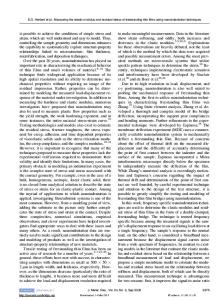Accurate Determination of the Elastic properties of Near Surface Regions and Thin Films Using Nanoindentation and Acoust
- PDF / 98,380 Bytes
- 6 Pages / 612 x 792 pts (letter) Page_size
- 51 Downloads / 295 Views
Accurate Determination of the Elastic properties of Near Surface Regions and Thin Films Using Nanoindentation and Acoustic Microscopy Matthew Bamber, Adrian Mann and Brian Derby. Manchester Materials Science Centre, UMIST and the University of Manchester, Grosvenor Street, Manchester, M1 7HS, UK.
ABSTRACT Nanoindentation has been successfully used as a mechanical properties microprobe to characterise the elastic properties of materials. However, in an isotropic material it is not possible to measure the two independent elastic constants by nanoindentation. Normally , a value of Young’s modulus is determined using an assumed value for Poisson’s ratio. It is also possible to use the acoustic microscope in its z-contrast mode to measure the elastic constants of a surface. This too produces a composite measurement of the elastic properties, which can be represented in terms of Young’s modulus and Poisson’s ratio. By using both techniques on the same sample area, it is possible to make two independent measurements of the elastic properties and thus determine both Young’s modulus and Poisson’s ratio. This method has been used on wellcharacterised bulk materials, e.g. silica glass, to demonstrate that it produces consistent results. It has also been uused to characterise thin films of TiN/NbN multilayers. These results show that, although for thin films there is a need to improve the analysis of the mechanics, the combination of nanoindentation and acoustic microscopy shows promise.
INTRODUCTION The development of thin film technology, multilayers, nanocomposites and microelectromechanical systems (MEMS) has led to a requirement for the determination of materials elastic properties with a very high spatial resolution. A number of experimental techniques have been developed which can probe the near-surface region of a material and are sensitive to material elastic properties. These include: nanoindentation, Brillouin scattering and V(Z) acoustic microscopy. All these techniques have been used successfully, but the results provide a combination of elastic constants (e.g. Young’s modulus and Poisson’s ratio). Here we describe an approach combining nanoindentation and V(Z) acoustic microscopy to obtain two independent measures of the elastic properties of the near-surface region. From these results it is possible to determine exactly the Young’s modulus and Poisson’s ratio of an isotropic material. Nanoindentation can be used to determine the elastic properties of a material using an expression for contact stiffness, S, derived from analyses by Love and Sneddon [1-4] S=
E A π (1 − ν 2 )
2
(1)
where E is Young’s modulus, ν is Poisson’s ratio and A is the contact area. The indentation is made by applying a small load (
Data Loading...











